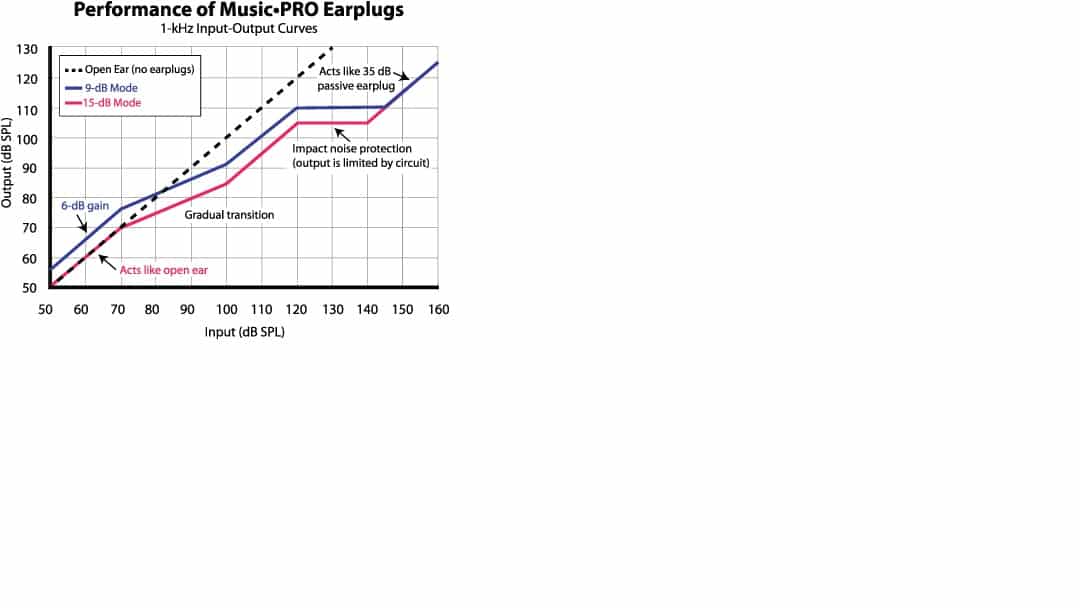It is certainly not my policy, nor the policy of this blog, to talk about specific products in the hearing health care field. But from time to time technologies become available that are only encompassed in one product. These are technologies that cause us to say, “Why didn’t I think of that?” or, in the words of Homer Simpson, “D’oh!” It is also not my policy to begin a sentence with the word “it,” but if Charles Dickens can do it, in A Tale of Two Cities (… “It was the best of times; it was the worst of times…”), I figure I can get away with it once in a blue moon.
Etymotic Research has come out with a most delightful innovation called the Music•PRO 9-15 electronic earplugs. These earplugs provide a slight amplification when needed, no amplification when not needed, and even attenuation where required. The “9-15” part of its name means that for its attenuation part, the earplug can provide either 9 dB or 15 dB of attenuation, much like the ER-9 and ER-15 Musicians Earplugs.™
But let’s take a step back (and I won’t talk about beginning a sentence with “But”).
A criticism of electronic earplugs is that, like all compression systems, they have a finite and well-defined attack time. Loud sounds such as a gun blast can get through before the system has had an opportunity to begin the compression. This is a false, albeit commonly heard, criticism. Here is why.
If an electronic earplug (or hearing aid with compression) is tested according to the most recent ANSI (or IEC) specification, the hearing aid test box rapidly changes its signal from 50 dB to 80 dB and back to 50 dB. This 30-dB sudden change will allow us to measure the attack time of the system as well as its release time. This works well for speech or speech-like signals. We may measure a 5-msec attack time with this approach and we say that the hearing aid has a 5-msec attack time.
However, if the ANSI or IEC paradigms had been designed for impulse sounds or music, we would have designed a test protocol that changes from 50 dB to 130 dB to 50 dB. This 80-dB jump is more consistent with the rim shots of the drum set as well as the blast of a gun. If the same hearing aid (as in the last paragraph) was tested with this newer protocol, the attack time would be on the order of microseconds (i.e., a fraction of 1 msec). The measured attack (and release) times are then a function of the stimulus levels that are used.
This is why electronic earplugs (such as blast plugs, or sound scoops, or any of the names that have been used in the industry) do indeed work.
A really neat side note about all of this that would make for fascinating conversation at your next dinner party is that in the next revision of ANSI for testing hearing aids, attack time and release time will be removed and placed in the appendix. It doesn’t mean that attack and release times are not important, but recall that the relevant ANSI and IEC specifications are merely reporting standards and not performance standards. Historically, attack and release time measures were included because they were a quick test of the capacitor that was used in analog hearing aids. Modern digital hearing aids accomplish the attack and release characteristics using software, so there is no capacitor to check. Trust me, this is a great topic for any party.
Back to the Music•PRO 9-15 electronic earplugs…. These earplugs, like all blast plugs, can provide attenuation (and respond very quickly) to those louder sounds that can be irritating and potentially damaging to your hearing. Unlike normal blast plugs, these plugs have a higher kneepoint (as seen on the graph) and are perfectly linear up to about 70 dB SPL. And, depending on the setting (9 or 15), there may be some low-level amplification. These earplugs are “acoustically transparent” (in the words of Cy Libby of Libby Horn fame) for quieter sounds and they are simply not there (at least electro-acoustically) when not needed. When they are, they automatically adapt by providing either 9 dB or 15 dB of attenuation. If the input sound is quite high then they automatically become the best earplugs possible, providing about 35-40 dB of attenuation. Forty dB is the greatest amount of attenuation possible because sound enters through the skull directly above that level, and through bone conduction the sound is transmitted directly to the cochlea bypassing the outer ear- another great party topic!
Oh, and one more thing. An attenuation of 9 dB (or 15 dB) does not sound like a lot, but let’s do some math. Every 3 dB of attenuation (which is barely detectable) is “one half the damage.” Another 3 dB of attenuation (now we’re down to 6 dB) is another one half, so it’s a quarter of the damage. And another 3 dB of attenuation means that we are down to 1/8 of the damage. So, 9 dB attenuation means that a person can be exposed 8 times as long as without hearing protection. If you were disposed to continue on to a calculation for an attenuation of 15 dB then that person can be exposed 32 times as long as without hearing protection. Attenuations of 9 dB and 15 dB don’t sound like a lot, but they definitely are.
And no, I don’t own stock in Etymotic Research, and there are days when I can’t even spell their name correctly.

This input-output curve is used with permission from Etymotic Design. For more information go to www.etymotic.com.






